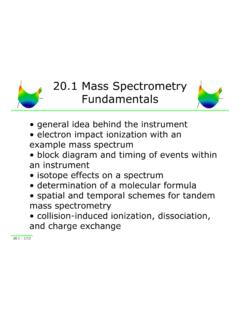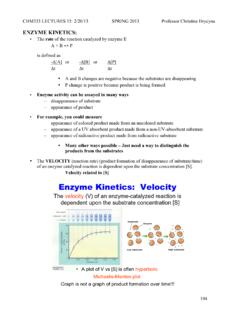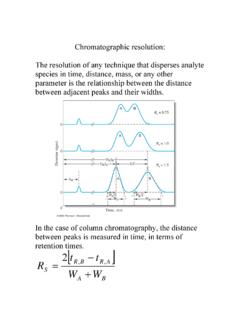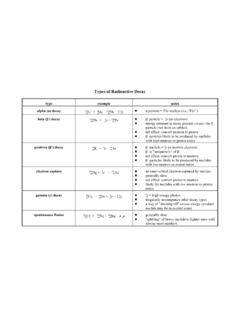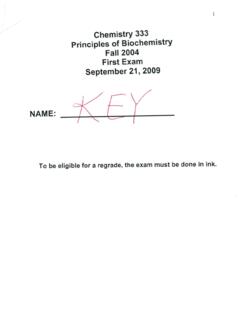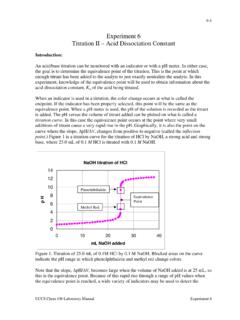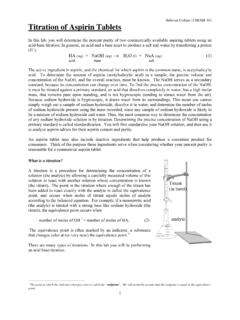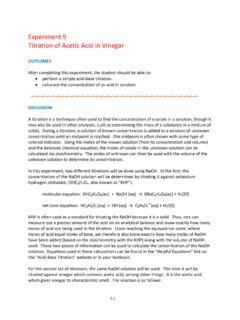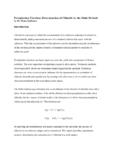Transcription of Experiment 2: Acid / base titration - Purdue University
1 Experiment 2: Acid / base titration mM @ 95% confidence levelunknownc= Nikolai Skrynnikov TA: Boone Prentice Section number: 1 25 Jan 2008 (data courtesy of Ike Fehrenbacher, 2004) 1 Introduction This laboratory exercise relies on a titration technique to determine an unknown concentration of monoprotic acid in solution. In the process of titration , a basic solution is gradually added to the acidic solution until complete neutralization is obtained. The end point of the titration is detected with the help of an indicator as color of the solution changes upon neutralization. By measuring the volume of the titrant required to reach the end point , it is possible to relate the concentration of the acid to the concentration of the base .
2 In this manner, the unknown concentration can be expressed through the known concentration. The concentration determination is repeated several times in order to improve the precision of the measurements and to estimate the experimental error. Results and discussion The Experiment involves two steps: (i) Standardization of sodium hydroxide (NaOH) solution using potassium hydrogen phtalate (KHP) solution, and (ii) titration of an unknown monoprotic acid solution using the standardized NaOH solution. The two steps, (i) and (ii), are essentially similar. Therefore, only the first step is briefly described below. The neutralization reaction proceeds as follows: NaOH + KHP Na+ + K+ + P2- + H2O Once this reaction is complete, an excess of NaOH starts building up, triggering the response from the indicator: NaOH + HIn(colorless) Na+ + In-(pink) + H2O.
3 An interesting question is why NaOH first reacts with KHP and only then, after KHP is consumed, it starts reacting with HIn. At this point I do not know the answer, but hope that this question will be addressed later in class. Another question arises as to why step (i) is needed at all. Indeed, one could envisage a simpler measurement scheme where the solution of NaOH is prepared with known concentration and used to titrate an unknown acid. Bear in mind, however, that NaOH is a poor primary standard: it is highly hygroscopic, chemically unstable (reacts with CO2 of air), typically low-purity (if purchased cheap), and has low molecular weight (which leads to higher relative error when the compound is weighed out). Conversely, KHP has many desirable characteristics which make it a good primary standard.
4 This dictates a choice of the two-step scheme, with KHP as a primary standard and NaOH as a secondary standard. 2 Standardization For the standardization step, the KHP solution has been prepared by weighing out g of (dried) KHP and dissolving it in distilled water to a volume of 250 mL. Considering that the molecular weight of KHP is MWKHP = g/mol, the concentration of the KHP solution is: [g] [L] [M] [mM] [g/mol]KHPc === The titration (standardization) results using mL aliquots of the KHP solution are summarized in Table 1 below. Trial 1* Trial 2 Trial 3 Initial volume [mL] Final volume [mL] Volume added [mL] end - Table 1. Volume data from NaOH standardization measurements using KHP solution.
5 The data are obtained from the buret readings. * Trial 1 was preceded with the scout titration (trial 0). The results from the scout titration are not included in this table since they are not quantitatively accurate. Already a cursory inspection of Table 1 shows that the results are highly reproducible the uncertainty in the volume of the titrant is on the order of mL ( ). The data from Table 1 can be used to determine the concentration of sodium hydroxide solution, . The molar balance conditions corresponding to the complete neutralization (end point of the titration ) can be written as: NaOHc [mol/L] [L] = [mol/L] [L]end - pointKHPKHPNaOHNaOHcVcV The concentration can be calculated on the basis of this formula, using , , and as listed in Table 1.
6 The values of calculated in this manner are , , and mM for trials i = 1, 2, and 3, respectively. The mean concentration, mMKHPc=25 mLKHPV=end- pointNaOHViNaOHcNaOHc, is mM. The uncertainty in is reported according to the standard recipe: NaOHc 3 NaOHNaOHtsccN= where 21()1 NiNaOHNaOHiccsN= = . Here is the number of measurements, N3N=, and t is the so-called Student s coefficient , assuming that the confidence level is 95% and that the number of degrees of freedom is . The sample standard deviation, , was calculated according to the above formula using the data from the individual trials, , and their mean, =siNaOHcNaOHc. This calculation produced mMs=. After rounding off the result and retaining the significant digits I obtained: mM @ 95% confidence levelNaOHc= The concentration of sodium hydroxide obtained in this fashion is further used to determine the concentration of the unknown.
7 titration of the unknown The titration results using standardized NaOH solution are listed in Table 2. Trial 1* Trial 2 Trial 3 Initial volume [mL] Final volume [mL] Volume added [mL] end - Table 2. Volume data from the titration of unknown monoprotic acid using standardized NaOH solution. The data are obtained from the buret readings. * Trial 1 was preceded with the scout titration (trial 0). The results from the scout titration are not included in this table since they are not quantitatively accurate. The subsequent calculations follow exactly the same steps as described above in the Standardization section. The balance condition at the end point of the titration is now 4used to determine the concentration of the unknown.
8 The volume used in this titration is 25 mL. (/end - pointunknownNaOHNaOHunknownccVV=)unknown V The concentration determined in this fashion is the main result of this study: unknownc mM @ 95% confidence levelunknownc= Control questions: (a) Why it is necessary to measure volumes very carefully when preparing the KHP solution (solution 5), but NOT necessary to measure volumes too carefully when preparing the dilute NaOH solution (solution 4)? The molarity of the dilute NaOH solution, , is not determined from the volumes of the concentrated NaOH solution and water added together. Instead, it is determined via the KHP titration . On the other hand, the molarity of KHP solution, NaOHcKHPc, is determined based on the mass of the KHP and the volume of water it is dissolved in.
9 (b) Why in step 2 should the pipet and beaker be rinsed with the KHP solution (not with distilled water), whereas the Erlenmeyer flasks should be rinsed with distilled water (not with the KHP solution)? Using the distilled water for rinsing may cause (unwanted) dilution of the KHP solution, and hence it is better to wash with the same KHP solution. The situation with the Erlenmeyer flask is different. It is only important that 25 mL of KHP solution with concentration KHPc are transferred to the Erlenmeyer flask. At this point, extra water left on the walls of the Erlenmeyer flask does not matter. Indeed, addition of water does not change the number of KHP molecules in the flask and, therefore, has no effect on the calculation of . NaOHc On the contrary, rinsing the flask with KHP solution would increases the number of KHP molecules in the flask and thus compromise the method.
10 (c) Give at least two reasons why it is better to read the initial volume of a buret than to adjust the volume to some round value such as zero. First, it is generally impossible to achieve a good accuracy by trying to fill a buret to some round value (human hands are not steady enough for this purpose). Reading the volume of a buret is more accurate (eyes are a more reliable instrument). Second, trying to fill a buret to a round value is time-consuming. Indeed, one has to add solution to a buret in small increments, constantly checking the resulting fluid level. 5 Conclusion This study demonstrates that the titration method relying on visual detection of the end point allows for fairly precise determination of the unknown concentration (relative error less than 1%).
